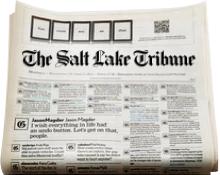This is an archived article that was published on sltrib.com in 2006, and information in the article may be outdated. It is provided only for personal research purposes and may not be reprinted.
JACOB LAKE, Ariz., - For the past three summers, Turkish exchange student Ibrahim Coskuner has worked for businesses at the North Rim of the Grand Canyon. But he has never seen anything like the wildland fire that for more than 20 days has turned forests into colorless piles of ash and obscured the national park with smoke.
On Wednesday, Coskuner was sent packing by the park business that employs him as the Warm Fire burned within 14 miles of the Grand Canyon National Park boundary.
"They moved us for safety reasons," he said. "I had only been working for three days."
Coskuner was one of about 85 workers - many, like him, from other countries - escorted 60 miles away to a high school in Fredonia until the park reopens at an unknown date.
The Salt Lake City Chapter of the American Red Cross, with support from chapters in Provo and St. George, set up a rows of cots at the school in the town five miles south of the Utah state line.
David Nealey, emergency service director of Salt Lake City's Red Cross chapter, said the relief organization's Arizona chapters are expected to start taking control of the effort today.
Utah responded first because of easier access to the area, which is severed from the rest of Arizona by the Grand Canyon.
On Tuesday, about 150 visitors to the North Rim were escorted by officials from the park because of safety concerns. The fire was started by lightning on June 8, and officials let it burn as a fire-use burn, in an area of the Kaibab National Forest thick with Ponderosa, and assorted conifer trees. A fire-use burn is essentially a controlled burn designed to rid the area of fuel.
On Sunday, the fire-use-burn situation changed, when winds, created by the intensity of the fire, caused it to explode into a firestorm that forced the closure of Arizona State Road 67 and turned nearly everything in its path into a pile of ash. The fire also encroached into a habitat area for the rare Mexican spotted owl.
By Sunday night, the fire had burned through the containment parameters established, triggering suppression efforts.
A high priority incident management team was brought in to fight the fire that so far has charred more than 58,000 acres. It is 40 percent contained, and so far has cost $4.2 million to fight. There have been no injuries and no structures have been lost in the fire.
Along the road Wednesday that leads from Jacob Lake to the entrance of the North Rim, the landscape still smoldered where the six-mile-wide wall of flame consumed everything in its path, leaving nothing but limbless trees standing like black match sticks jabbed in the ground.
The Forest Service has been criticized by residents in surrounding communities, including Fredonia and Kanab, for not taking quicker action to contain the fire, but Brian Steinhardt, the acting fire management officer for the North Kaibab District of the forest, said Wednesday the fire was necessary to restore the forest to health after nearly a century of suppression that let fuels build up.
"The forest was in decay," said Steinhardt. "This [fire] will make the forest healthier by adding nutrients to the soil and producing big, healthier trees for future generations."
He said the fire did what it was suppose to do and he would make the same decision again.
"I stand by my decision, and would do it again," he said.
Steve Rich, who with other family members, owns and operates Jacob Lake, a well-known resort that has been selling gas and renting rooms to Grand Canyon visitors since 1923, said the decision to not actively suppress the fire at the beginning was a bad decision and devastating to the resorts bottom line.
He said the 67 rooms for rent at the resort are barely half full now, mostly firefighters and news crews, after several hundred reservations were canceled because of the fire.

